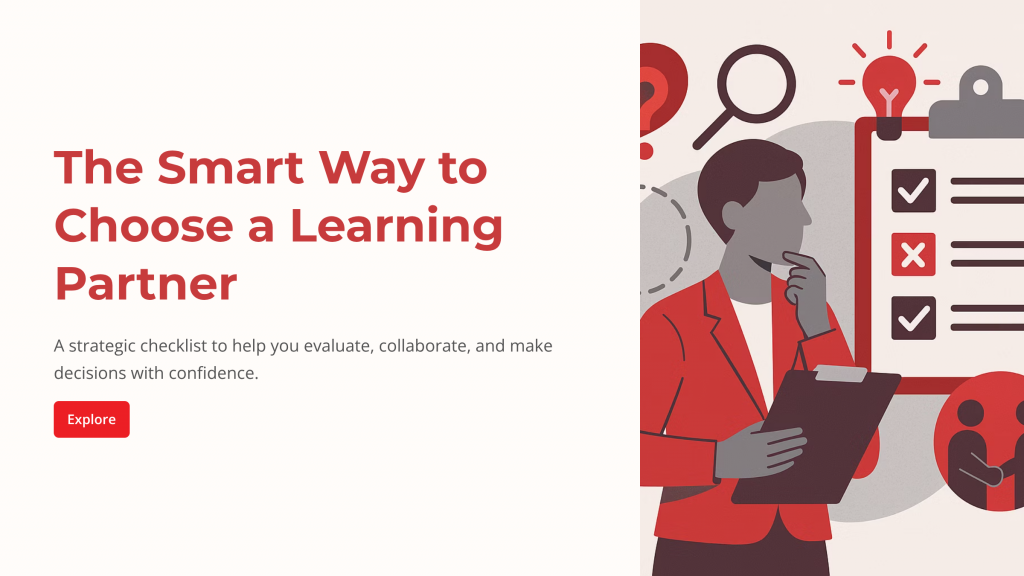
Choosing the right eLearning solutions provider isn’t a procurement decision; it’s a strategic move that directly impacts how your teams learn, grow, and perform. In a rapidly shifting landscape shaped by hybrid work, digital transformation, and increasing compliance demands, organisations need learning partners who bring creativity, agility, and results.
Table of Contents
The challenge? The marketplace is crowded with providers promising innovation, yet too often delivering templated solutions that miss the mark. For corporate training managers, HR leaders, and L&D strategists, knowing what to look for (and what to avoid) can make all the difference.
This checklist is designed to help you evaluate eLearning providers through a strategic lens.
Vendor Evaluation: Key Questions to Ask Before You Sign the Contract
A thorough vendor evaluation process is essential to ensure your learning partner aligns with your strategy, understands your audience, and delivers lasting value.
Here are key questions to ask as you assess potential providers:
Do they understand your business and learning goals?
Effective learning isn’t built in a vacuum. Your provider should demonstrate a clear understanding of your sector, your workforce, and the outcomes you’re aiming to achieve. Look for signs that they’ve worked with similar challenges: and that they ask thoughtful questions during the discovery process.
What to listen for: Insightful references to your learning audience, operational context, and long-term goals.
Can they tailor solutions to your specific needs?
Many vendors offer templated modules with limited flexibility. Strategic partners, on the other hand, deliver custom solutions: combining content strategy, instructional design, and media production to reflect your culture, values, and learning outcomes.
What to ask: “How do you approach customisation?” and “Can you walk us through a tailored solution you’ve delivered?”
What is their expertise in instructional design and digital learning?
Quality eLearning goes beyond aesthetics. Strong instructional design ensures learning is relevant, accessible, and aligned to behavioural or performance goals. Explore the provider’s design methodologies, accessibility standards, and learning science principles.
What to request: Examples of storyboards, learning paths, or scenario-based modules they’ve developed.
Do they have the right technical capabilities?
Scalable digital learning requires seamless tech integration. Evaluate how the provider supports platforms like your LMS or LXP, mobile delivery, analytics, and interoperability with formats such as SCORM or xAPI.
Checklist prompt: Does the vendor demonstrate fluency in your tech ecosystem; or will integration be an afterthought?
What proof points back their claims?
Reputation matters. Look for case studies, client references, and performance metrics that reflect real-world success: not just theoretical capabilities.
Ask directly: “Can you share outcomes from a similar project?” and “How do your solutions support continuous learning beyond launch?”
L&D Outsourcing That Actually Works: Collaboration, Communication, and Culture Fit
Outsourcing learning and development shouldn’t feel like handing off a task: it should feel like gaining a partner. When L&D outsourcing is done well, it enables your internal teams to focus on strategic direction while your external partner drives innovation, execution, and continuous improvement. The key? True collaboration and cultural alignment.
Are they genuinely collaborative, or just delivering content?
A transactional provider might offer a pre-scoped product. A strategic partner will co-create, challenge assumptions, and evolve solutions with you. That means being flexible, curious, and engaged from discovery through delivery.
Look for: A collaborative approach to onboarding, open dialogue during design sprints, and iterative feedback loops that welcome your voice.
How do they handle communication and project management?
Strong L&D outsourcing relationships thrive on clarity and consistency. Ask how communication is managed: are there regular check-ins, shared timelines, proactive updates, and a dedicated point of contact?
Checklist tip: Providers should integrate seamlessly with your workflow, not create extra effort. Evaluate their tools, processes, and responsiveness.
Does their team align with your organisational culture?
A great culture fit enhances every stage of a project. It’s reflected in tone, values, decision-making, and how they handle pressure or change. When an outsourced partner shares your commitment to inclusion, innovation, and integrity, collaboration becomes more effective (and more enjoyable).
Ask yourself: Do they demonstrate empathy, adaptability, and accountability? Would you feel comfortable putting them in front of your stakeholders?
Choosing a Learning Partner, Not Just an eLearning Solutions Provider
From robust vendor evaluation to alignment on communication and culture, your checklist should reflect not only what you need now, but what will sustain long-term impact. Look beyond the platform and the product. Prioritise providers who demonstrate insight, adaptability, and a commitment to your success.
If you’re looking for an eLearning solutions provider who will collaborate, challenge, and co-create with you, let’s talk. Anderson Studios works with corporate training leaders, HR professionals, and industry teams to deliver tailored, creatively inspired learning that drives results.
Contact Anderson Studios and let’s build something impactful together.

